Frigate Design Awards By April; $950M Max, VLS Mandatory
Posted on
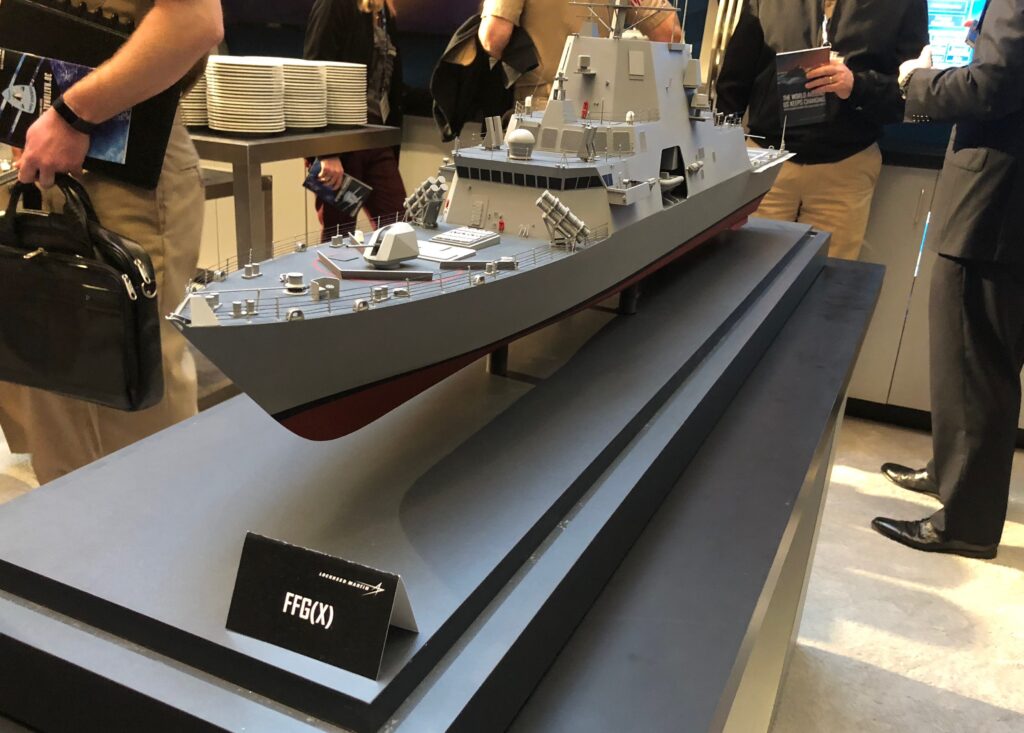
Lockheed Martin model of their proposed frigate design, based on the Littoral Combat Ship, on display at the 2018 Surface Navy Association conference. Note VLS hatches on foredeck, behind turret and flanked by OTH launchers.
UPDATED with CNO comment on importance of program CRYSTAL CITY: By the end of March, the Navy will award four to six contracts for “conceptual” designs of a future frigate. That ship that must cost under $950 million, have “Grade A shock hardening” on key systems to survive blasts, and carry at least 16 Vertical Launch System cells to defend itself and nearby vessels, program manager Regan Campbell told the Surface Navy Association conference here.
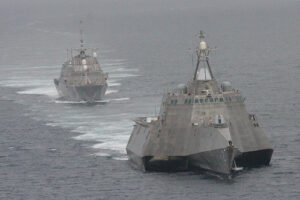
LCS-2, USS Independence, followed by LCS-1, USS Freedom, showing the two different designs.
Those requirements, among many others, demand a much more formidable and more expensive vessel than the current, controversial Littoral Combat Ship. They make winning harder for the builders of the two existing LCS variants — Marinette Marine’s Freedom monohull and Austal’s Independence trimaran — which are making ships for under $500 million apiece that lack VLS and heavy-duty shock hardening. On the other hand, that $950 million maximum may be a challenge for the larger and more capable foreign frigates in the competition.
A crucial caveat: The forthcoming decision doesn’t knock anybody out of the competition. The four to six winners will split $90 million to do conceptual designs due in 16 months, and they’ll get intensive feedback from the Navy how to improve their work. But the Navy will also keep updating a “bidders’ library” with the latest specifications and files of Government Furnished Information (GFI), which will be available to all interested and qualified parties. When the government issues its final Request For Proposals (RFP) late this year — in the first quarter of fiscal year 2019 — any company can enter the “full and open competition,” even if they didn’t get a conceptual design contract.
The choice that really counts will come in 2020, when the Navy chooses one design to actually build. The first ship will be bought in 2020 (and delivered in 2026), the second in ’21, and two a year after that.
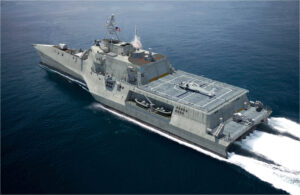
Austal’s proposal for an LCS frigate with Vertical Launch System (VLS) tubes.
That $950 million figure is the maximum average price allowed for ships two to 20: The first of class can (and almost certainly will) go higher. Those caveats aside, the $950 million is the real average cost per ship, including the Government Furnished Equipment (GFE) provided by the Navy rather than the winning contractor. (You can hide hundreds of millions in costs by not counting all GFE).
The Government Furnished Equipment will be expensive, Campbell said, to ensure that whichever design wins, it will have compatible technology with the rest of the fleet. Used tried-and-true tech also reduces cost and risk. That includes standard Navy radars and the COMBATSS-21 combat management system, a dialed-down derivative of the Aegis air and missile defense system used on destroyers. (By contrast, the original LCS were allowed to use sui generis electronics, creating all sorts of headaches).
The GFE also includes Mark 41 Vertical Launch Systems, specifically the full-size “strike length” version capable of carrying the Navy’s entire array of offensive and defensive missiles. Earlier frigate concepts had made VLS optional; now it’s mandatory, Campbell made clear. 16 VLS cells is the minimum, 32 the preferred or “objective” number. In addition, the frigate needs eight dedicated on-deck launchers for Over-The-Horizon anti-ship missiles.
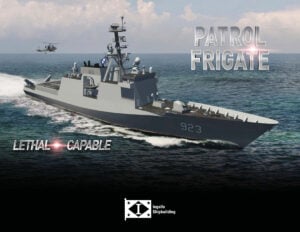
Huntington Ingalls concept for their Patrol Frigate, a militarized version of their Coast Guard National Security Cutter.
The VLS cells, by contrast, are primarily needed for anti-aircraft and anti-cruise-missile weapons, like the SM-2 Standard Missile and the ESSM Sea Sparrow. (Though VLS can load offensive weapons if the situation warrants, she said). These defensive weapons are not just to protect the frigate itself but nearby vessels for which it’s providing “close escort.” How close? Campbell carefully didn’t say — details are classified — but she made clear there was no appetite, and no money, for the frigate to replicate the extensive air and missile defense capabilities of a full-size Aegis destroyer.
While better armed and better protected than LCS, the future frigates will still — like LCS — serve as the “low” half of a “high-low” mix alongside destroyers and cruisers. Unlike LCS, however, the frigates will have the VLS, shock hardening and reinforced hull structures to accompany the destroyers into so-called contested environments under threat from a hostile and well-armed enemy. That’s a big shift from the early vision for LCS. The frigates will also have the command, control, and communications systems to work with amphibious and aircraft carrier task forces. In short, the Navy doesn’t want an auxiliary ship: It wants a frigate that can fight with the fleet.
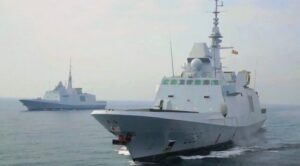
France’s first two FREMM frigates, the Aquitaine and the Normandy, built by Italy’s Fincantieri.
UPDATE On an even larger scale, the frigate is a test case for a new and more streamlined approach to shipbuilding, the Chief of Naval Operators told reporters later at the conference. “We’ve been doing anything we can to reform our (acquisition) processes so we can challenge the assumptions, particularly (for) shipbuilding — I think we can just do that a little faster,” Adm. John Richardson said. “The one that we’re going to see, I hope, a big step forward in that regard is the frigate program.”
UPDATE We need to get the frigate right, Adm. RIchardson said, “not only because we need those ships, but also we’re really trying to approach how we design and build of our ships differently, which might define a new era in shipbuilding.”
Subscribe to our newsletter
Promotions, new products and sales. Directly to your inbox.
